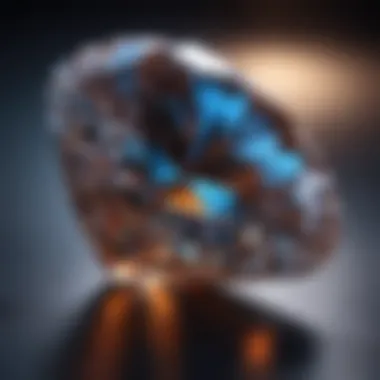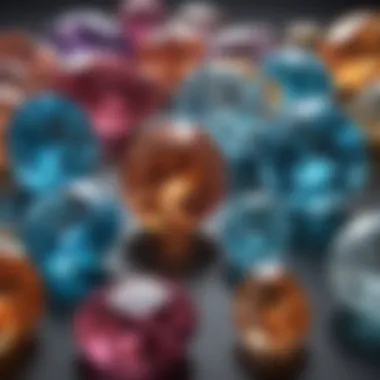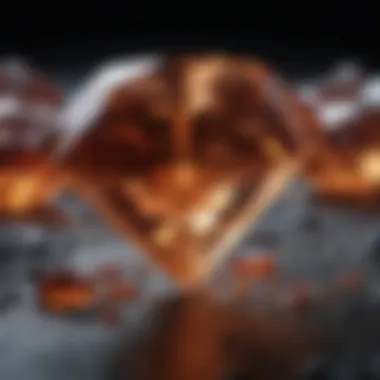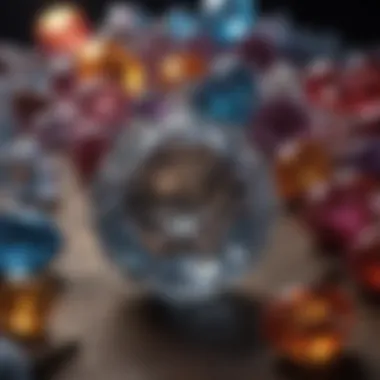Exploring Diamond Luminescence: Science and Mystique


Intro
The allure of diamonds is timeless, captivating countless admirers throughout history. But did you know that some diamonds exhibit a fascinating phenomenon known as luminescence? This article seeks to illuminate the intricacies of luminescence in diamonds, comparing their glowing characteristics with other gemstones. We'll dive into the scientific principles, factors influencing their performance, and the impact of cultural significance in the context of gemstones.
Gemstone Overview
Definition and Origins
Diamonds, a form of carbon crystal, are the hardest natural substance known. Formed under high-pressure conditions deep within the Earth's mantle, their journey to the surface often involves volcanic activity. The term "diamond" comes from the Greek word "adamas," meaning invincible or untameable. Their brilliance and durability lend them both beauty and mystique, qualities that have made them highly sought after.
Historical Significance
Historically, diamonds have been symbols of wealth, power, and love. They have adorned crowns, been used in royal adornments, and represent eternal bonds in engagement rings. The allure of diamonds has sparked numerous legends; in India, diamonds were believed to hold protective spells against evil.
Gemstone Properties
Hardness and Durability
Diamonds score a perfect 10 on the Mohs scale of hardness, an impressive feat that underscores their unparalleled durability. This resilience makes them ideal for everyday wear, particularly in rings. However, it's important to note that certain inclusions or flaws can lead to fractures if sufficient force is applied.
Color and Clarity
When discussing diamonds, clarity and color become significant touchpoints. While colorless diamonds are often the yardstick for purity, various shades—from light yellow to deep blue—can affect their desirability and value. Inclusions might create unique optical effects, impacting how light interacts with the gemstone and, intriguingly, its luminescent properties.
"Diamonds reflect more than light; they hold stories, history, and even science within their facets."
Woven into these discussions is the complex relationship between treatments and environmental factors. For instance, diamonds enhanced through laser drilling or high-temperature annealing might display different luminescent traits compared to their untreated counterparts. As we navigate the depths of luminescence in diamonds, it is essential to underscore these contributing factors.
Understanding Luminescence
Luminescence provides a fascinating lens through which we can explore the beauty of diamonds and other gemstones. It's not just a scientific term; it embodies the interplay of light, color, and perception, transforming how we view these natural wonders. Understanding luminescence is crucial for anyone interested in gemstones. It opens the door to comprehend the intricacies of how light interacts with these stones, revealing hidden beauty often unnoticed at first glance.
Many individuals collect gemstones not only for their physical features but also for their unique properties. After all, who wouldn't be captivated by a diamond that glows under UV light, revealing an ethereal blue hue? It doesn't only add to their allure but also enhances their value and significance. This exploration into luminescence paves the way for richer conversations about inclusions, colors, and overall quality of stones. The phenomenon of luminescence is a dance of science and aesthetics, making it a focal point of this discourse.
Defining Luminescence
Luminescence refers to the emission of light by a substance not resulting from heat. In simple words, it’s when a material gives off light due to a chemical reaction, a change in temperature, or other processes. This characteristic is crucial in differentiating gemstones and understanding their behavior under various light sources. It goes beyond mere sparkle, delving into the realm of chemistry and physics. Essentially, the luminescent properties of a gemstone can tell stories about its journey from the depths of the earth to its place in a display case.
Different Types of Luminescence
Luminescence can be categorized into several types, each with distinct mechanisms and implications for gemstones, particularly diamonds. Let’s delve deeper into three prominent forms: Fluorescence, Phosphorescence, and Chemiluminescence.
Fluorescence
Fluorescence is perhaps the most commonly recognized type of luminescence. When exposed to certain wavelengths of light, materials absorb energy and emit it almost immediately as a different wavelength. This happens quickly, typically within nanoseconds. One of the most fascinating aspects of fluorescence in diamonds is its ability to create a vivid blue glow, especially under ultraviolet (UV) light. This glow is often seen as desirable by collectors and appraisers, as it can enhance the appearance of clarity and color. However, it is essential to understand that some fluorescent diamonds may appear cloudy or yellowish under natural light, which can affect their overall value.
- Key characteristic: Immediate light emission upon UV exposure.
- Advantages: Enhances visual appeal, making stones look brighter and clearer.
- Disadvantages: Potential for a less favorable appearance in natural light conditions.
Phosphorescence
Phosphorescence differs from fluorescence in that it involves a delayed release of absorbed energy. A material that is phosphorescent will continue to glow even after the initial light source is removed. This can last from mere seconds to several hours, depending on the material. In gemstones, it’s less common than fluorescence but can add a unique aspect to specific stones. Phosphorescent diamonds are intriguing, as they might show an afterglow effect under certain conditions, making them an impressive centerpiece in any collection.
- Key characteristic: Delayed light emission after the light source is removed.
- Advantages: Unique and captivating glow that can enhance desirability.
- Disadvantages: It might not be universally recognized or valued, potentially leaving some buyers puzzled.
Chemiluminescence
Chemiluminescence is a fascinating type of luminescence that occurs through a chemical reaction, typically without involving heat. This is the principle behind glow sticks, where a chemical mixture produces light upon activation. While not commonly associated with diamonds, understanding this phenomenon expands our knowledge of luminescence as a whole. In the context of gemstones, chemiluminescence is more relevant for synthetic counterparts rather than natural stones like diamonds. However, its study offers valuable insights into the vast array of luminosities one might encounter in diverse materials.


- Key characteristic: Light produced through chemical reactions.
- Advantages: Provides a unique context for understanding luminescence beyond natural stones.
- Disadvantages: Less common in the gemstone world, mainly seen in synthetic or treated materials.
The Science Behind Diamonds
Understanding the scientific principles behind diamonds plays a pivotal role in appreciating their unique characteristics, including luminescence. This section delves into the composition and structure of diamonds, illustrating how they interact with light. The fascinating interplay between their crystalline forms and the light that strikes them results in striking optical phenomena, including the much-discussed glow. The analysis of diamonds under various conditions will enable gemstone enthusiasts and collectors to better grasp why some diamonds exhibit luminescence while others do not. This knowledge can potentially influence purchasing decisions and enhance the emotional value associated with these gems.
Diamond Crystal Structure
At the heart of any diamond lies its intricate crystal structure. Diamonds are composed of carbon atoms arranged in a tetrahedral formation, which creates an exceedingly strong bond. This unique arrangement is responsible for the exceptional hardness that diamonds are known for, rated a ten on the Mohs scale.
The strength of a diamond's structure means that light behaves differently as it penetrates the stone, leading to remarkable optical properties.
In addition to their hardness, the symmetrical arrangement of carbon atoms allows for a high level of precision in how diamonds refract light. This refractive ability is fundamental in understanding how diamonds can glow under certain circumstances. When light hits a diamond, it is not just reflected; it refracts, bending and splitting the light into its constituent colors. Such properties are instrumental for anyone wanting to appreciate or evaluate a diamond’s quality.
How Light Interacts with Diamonds
The interaction of light with diamonds can be dissected into several aspects, particularly refraction and dispersion, each playing a crucial role in their visual appeal.
Refraction
Refraction in diamonds occurs when light passes through the crystalline structure, bending as it does so. This bending is chiefly due to the high refractive index of diamonds, which measures how much they can alter the light’s path.
Key Characteristics of Refraction:
- Bending of Light: When light enters a diamond, it slows down and changes direction. This is significant as it contributes to the gem's brilliance.
- Depth of Color: Through refraction, diamonds can exhibit a range of colors, enhancing their aesthetic value.
Refraction is a beneficial aspect to discuss in this article as it provides insight into how light can interact at various angles, affecting the overall luminosity of a diamond. A unique feature of this phenomenon is that it creates a sparkle visible at certain angles, making diamonds even more captivating.
Dispersion
Dispersion takes the conversation a step further, referring to the split of light into a spectrum of colors as it exits the diamond. This separation creates the rainbow-like effects often associated with high-quality diamonds and is sometimes referred to as fire.
Key Characteristics of Dispersion:
- Color Spectrum: Different wavelengths of light emerge separately, which means diamonds can show reds, greens, and blues when viewed from various angles.
- Vivid Display: The visual play of colors adds another layer of allure to these stones, making each interaction with light unique.
Dispersion is also of great value in this article as it underscores the complexity and beauty of diamond luminescence. The unique feature here lies in how this optical property can vary from stone to stone, influenced by factors like cut quality and clarity.
In summary, the scientific aspects of diamonds not only explain their luminous features but also enrich the understanding of their allure for collectors and enthusiasts alike. Knowing how light interacts with diamonds serves to deepen appreciation for these remarkable gemstones.
Fluorescence in Diamonds
Fluorescence in diamonds is a captivating topic that bridges the realms of science and aesthetics. This phenomenon doesn't just contribute to the allure of these stones; it's a vital element in understanding their natural beauty and valuation. Many gem enthusiasts and collectors are particularly keen on how fluorescence can alter a diamond's appearance under certain lighting conditions, thus affecting both desirability and market price.
The blue glow that some diamonds exhibit when exposed to ultraviolet (UV) light can serve as a distinguishing feature. This can be beneficial in identifying authenticity since synthetic diamonds often display different luminescent properties. Moreover, understanding fluorescence allows buyers to appreciate the nuances in appearance and grading, providing a more informed buying experience.
What Causes Blue Glow?
The blue glow in diamonds primarily comes from the presence of trace elements, mainly nitrogen. When diamonds are formed deep within the Earth, they can incorporate nitrogen atoms into their crystal lattice.
- Nitrogen's Role: When exposed to UV light, these nitrogen atoms absorb energy and re-emit it at a longer wavelength, which typically appears blue to the naked eye.
- Variability: Not all diamonds have the same degree of fluorescence. Factors like the amount and type of nitrogen present play a role, which explains why two diamonds can look very different even when they share similar grading.
Additionally, some diamonds can exhibit other colors of fluorescence, depending on their chemical composition and the impurities they contain.
Variations in Intensity
Fluorescence isn’t a one-size-fits-all phenomenon when it comes to diamonds. The intensity of the glow can vary widely among different stones.


- Categories of Intensity:
- Market Perception: It's interesting to note that the market has varying attitudes towards fluorescence. While some buyers see it as a desirable trait that adds character, others may view it as a drawback, particularly if it affects the color perception of a diamond in daylight.
- None: Some diamonds exhibit no fluorescence at all, which can be ideal for collectors who prefer a classic appearance.
- Faint: This category shows a subtle glow that may not always be noticeable under regular light conditions.
- Medium: These diamonds will exhibit a more pronounced glow under UV light, enhancing their uniqueness.
- Strong: A strong fluorescence can create dramatic effects, especially in colored diamonds, making them more desirable to some buyers.
Understanding these variations can help buyers make choices that align with their personal preferences and budget.
"Fluorescence can either elevate a diamond's beauty or create concerns about its authenticity, a phenomenon that reflects the complexity of human perception in design."
Factors Influencing Diamond Luminescence
Understanding the elements that influence the luminescence of diamonds is crucial for anyone interested in gemstones. The glowing properties of diamonds don't appear in a vacuum; they are the byproduct of a myriad of factors at play beneath the surface. From the atomic structure to the presence of impurities, different elements can radically alter how a diamond reacts to light and, consequently, how it exhibits luminescence. Additionally, the treatments diamonds undergo can further enhance or diminish these glowing characteristics.
Impurities and Inclusions
Diamonds aren’t just simply carbon, as many might assume. They often contain other elements, known as impurities, that can change their optical properties significantly. These impurities can range from nitrogen to boron, each impacting luminescence in distinctive ways.
For instance, nitrogen, which is commonly found in natural diamonds, can cause yellowish hues and sometimes lead to fluorescence. A diamond rich in nitrogen can often glow brilliantly under ultraviolet light, showcasing a vibrant blue or green hue, reflecting its internal identities.
Inclusions, or flaws within the diamond, also play their part in this intricate dance of luminescence. Various types of inclusions, such as pinpoint inclusions or feather-like characteristics, can confuse light rays, which leads to scattered beams creating an enchanting display when light hits the diamond. It’s a juxtaposition of beauty and imperfection that cultivates the uniqueness of each stone.
Impact of Treatments
Alongside natural characteristics, diamonds go through various treatments that can modify their luminescent qualities.
High Pressure, High Temperature (HPHT)
High Pressure, High Temperature (HPHT) treatment is often utilized to enhance a diamond's clarity or change its color. This method mimics the natural processes that form diamonds deep within the Earth. When subjected to extreme conditions, the internal structure of the diamond can be altered, and sometimes the luminescent properties can be dramatically enhanced as well. The key characteristic of HPHT is its ability to transform lower-quality diamonds into ones that are more sought after on the market.
However, HPHT diamonds may also have specific disadvantages. For example, the treatment can sometimes result in a cloudier appearance, and clear distinction between natural and treated stones can be complicated for buyers to ascertain.
Laser Drilling
On the other hand, laser drilling is a treatment that specifically addresses inclusions. This method employs lasers to create tiny passages in diamonds, allowing for the removal or alteration of inclusions deemed undesirable. The primary impact of laser drilling on luminescence is profound. Holes left by the laser can scatter light differently than natural inclusions, which can either enhance or diminish the glowing qualities of the stone.
In this case, the beneficial aspect of laser drilling lies in its ability to make diamonds appear clearer. However, it’s also crucial to note that buyers may view these modifications with skepticism, sometimes associating them with reduced value or authenticity.
In summary, understanding the factors that influence diamond luminescence is vital for collectors, jewelers, and enthusiasts alike. By recognizing the roles that impurities, inclusions, and treatment methods play, one can make more informed decisions when purchasing or evaluating diamonds.
Differences Between Diamonds and Other Gemstones
Understanding the distinct attributes of diamonds in comparison to other gemstones adds depth to our appreciation of luminescence. Each gemstone contributes uniquely to the phenomenon of glowing under certain conditions. In this section, we will examine these differences by delving deeper into three prominent gemstones—rubies, sapphires, and emeralds—while also acknowledging the cultural significance tied to luminescent gemstones.
Comparative Analysis of Luminescence
Rubies
Rubies are well-known for their striking red hue, often considered the king of gemstones. Their contribution to this article lies in their unique luminescent quality, particularly under ultraviolet light. What makes rubies special is the presence of chromium, which is responsible for their beautiful color and strong fluorescence. This characteristic not only enhances the visual appeal of rubies but also their status in the market.
Rubies can emit a red glow when exposed to UV light, a quality that makes them particularly attractive to collectors. However, one must also consider the trade-offs. The intensity of the glow can vary significantly due to the quality and clarity of the stone, as well as the specific treatment it might have undergone. For someone looking to invest in precious stones, understanding these subtleties is essential.
Sapphires
Sapphires, particularly known for their deep blue variety, showcase an interesting aspect of luminescence. When compared to rubies, sapphires exhibit a more subdued glow, thanks in part to the presence of iron and titanium within their structure. This contributes to their renowned durability and makes sapphires a favorite for various types of jewelry.
The key characteristic of sapphires lies in their versatility. They can be found in countless colors, providing an expansive selection for collectors and designers alike. However, while their luminescent properties exist, they often lack the vibrant glow seen in rubies. This can be a disadvantage for buyers specifically searching for pronounced fluorescent qualities in their gemstones.
Emeralds


Emeralds, with their lush green color, are yet another fascinating member of the gem family. Their luminescence usually takes a back seat compared to that of diamonds, rubies, and sapphires. The reason is largely due to the presence of various inclusions, mainly due to the natural formation process. While some emeralds do exhibit a slight glow under UV light, it’s often less predictable than with rubies or sapphires.
The beautifully rich color of emeralds and their rarity can make them particularly appealing for jewelry. However, the less predictable luminescence can be a drawback for those specifically interested in the glowing aspect of gemstones. Collectors who appreciate nuances in gemstone characteristics will value knowing these details about emeralds.
Cultural Significance of Glowing Gemstones
The allure of luminescent gemstones transcends their physical characteristics—these gems carry significant cultural weight across various societies. In many cultures, glowing stones are viewed as possessing mystical properties or are believed to bring good luck. For instance, rubies often symbolize love and passion, while sapphires are linked to wisdom and royalty.
Emeralds, with their vibrant hue, often signify rebirth and renewal. This cross-cultural appreciation enriches our understanding of the emotional connection people have with these gemstones. Moreover, understanding these cultural contexts enhances the overall dialogue surrounding the aesthetic qualities and investment value of these stones.
"Gemstones are not just treasures of the earth; they are deeply woven into the fabric of human history and societal values."
Through this comparative exploration of diamonds, rubies, sapphires, and emeralds, we grasp the complex tapestry of properties that make each gemstone distinctive. In recognizing their differences, we deepen our understanding of how luminescence plays a critical role in the appreciation of these natural wonders.
Practical Considerations for Buyers
When it comes to investing in diamonds, understanding their luminescence is not just a fascinating science but a practical concern for potential buyers. This section illuminates the significant aspects of luminescence, guiding buyers through the intricate world of diamonds and the role that fluorescence plays in their appeal and value.
Evaluating Fluorescence in Diamonds
Fluorescence in diamonds can greatly affect their overall appearance when exposed to ultraviolet light. While some may favor a diamond that exhibits no fluorescence, others might appreciate the unique character it brings. It’s essential to see how different levels of fluorescence can both enhance or detract from the perceived beauty of a diamond when viewed under regular lighting versus UV light.
Before purchasing, potential buyers should inquire about fluorescence grading. Often, jewelers will provide this information, but it's wise to independently assess this property. A diamond with medium to strong fluorescence can sparkle more intensely in bright light conditions, while one with none might appear more subdued. Therefore, buyers should weigh personal preference against how fluorescence can factor into the diamond’s appeal, clarity, and price point.
Purchasing Guidelines
When purchasing a diamond, a few guiding principles can help solidify a wise investment:
Budget Considerations
Budget isn't just an amount; it's the framework of a buyer's diamond adventure. Understanding how fluorescence can impact price is key. Generally, diamonds with strong fluorescence may be available at a lower cost than those without, creating an opportunity for buyers seeking value. Here, the unique feature of fluorescence becomes an advantage; it may allow a buyer to purchase a larger, more visually striking stone for less than its non-fluorescent counterpart.
However, it’s important to consider that a strong glow under UV light might not always align with your desired aesthetic. Thus, a careful assessment of your preferences alongside your budget ensures a fulfilling purchase.
Authenticity Verification
Authenticity verification is critical when making a significant investment such as a diamond. This involves confirming the diamond's origin, treatment history, and quality grading. Reputable vendors will offer certification from recognized gemological laboratories. A key characteristic here is that proper certification can provide peace of mind regarding the diamond’s authenticity and grading accuracy. The upsides of thorough verification help in avoiding counterfeit products and ensure the buyer is getting what they pay for.
It is worth noting, though, that not all authentication services are equal. Some might offer questionable accuracy, leading to potential disappointments later. Thus, while authenticity verification plays a beneficial role, diligent research into the credibility of the certification agency is essential.
"Knowledge is power, especially in the diamond market. Make informed decisions that resonate with not only your budget but your personal style as well."
The End
The exploration of luminescence within diamonds reveals not just the beauty but also the intricate scientific principles governing these gemstones. Understanding how and why diamonds glow isn't merely an aesthetic curiosity; it serves as a gateway to appreciating the broader geological and cultural narratives surrounding these coveted stones.
The importance of the topic lies also in the various factors influencing luminescence, such as impurities that can lend character while also affecting the gem's market value. This understanding can be a game changer for gemstone enthusiasts and collectors, allowing them to make more informed decisions. It’s about knowing what kind of glow brings out the spirit of a diamond and its place in both nature and society.
Moreover, comprehending how diamonds interact with light equips jewelry designers with essential insights, enabling them to enhance the visual appeal of their creations. The market today is saturated with so much information, and buyers need to discern the practical considerations outlined in this article.
Summary of Key Points
In this discourse, several critical elements regarding diamond luminescence have been brought to light, including:
- Definition and Types of Luminescence: Distinctions between fluorescence, phosphorescence, and chemiluminescence.
- Scientific Framework: How the diamond's unique crystal structure interacts with light.
- Cultural Relevance: Historical and societal impacts of glowing gemstones, particularly diamonds.
- Practical Guidelines for Buyers: Evaluating fluorescence and considerations for authenticity.
Each of these points contributes to a comprehensive understanding of the diamond's glow, making it evident that there's more than meets the eye.
Future Research Directions
As this field evolves, further inquiries could yield fascinating insights. Future research might explore:
- Environmental Effects: How different conditions and settings can perhaps enhance or reduce luminescent qualities in diamonds.
- Technological Approaches: Innovations in treating diamonds to control luminescence, possibly creating new avenues in jewelry design.
- Broader Gemstone Comparisons: Further studies contrasting diamond luminescence with other gemstones, potentially revealing undiscovered patterns of behavior.
Finally, the intricate dance of light and matter that makes diamonds glow is a topic rich with potential that extends beyond mere appreciation of beauty.



